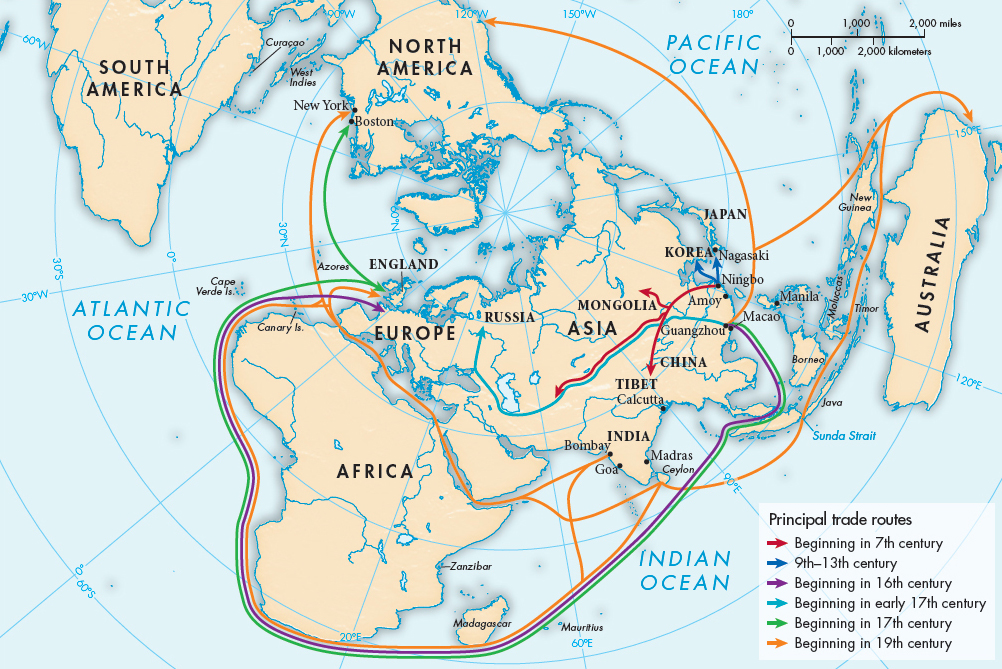A History of World Societies:
Printed Page 366
Global Trade
Tea is made from the young leaves and leaf buds of Camellia sinensis, a plant native to the hills of southwest China. As an item of trade, tea has a very long history. By Han times (206 B.C.E.–220 C.E.) tea was already being grown and drunk in southwest China, and for several centuries thereafter it was looked on as a local product of the region with useful pharmacological properties, such as countering the effects of wine. By Tang times (608–
The most intensive time for tea production was the harvest season, since young leaves were of much more value than mature ones. Mobilized for about a month each year, women would come out to help pick the tea. Not only were Chinese tea merchants among the wealthiest merchants, but from the late eighth century on, taxes on tea became a major source of government revenue.
Tea circulated in several forms, loose and compressed (brick), powder and leaf. The cost of tea varied both by form and by region of origin. In Song times (960–
The Song Dynasty established a government monopoly on tea. Only those who purchased government licenses could legally trade in tea. The dynasty also used its control of tea to ensure a supply of horses, needed for military purposes. The government could do this because its neighbors that produced horses — Tibet, Central Asia, Mongolia — were not suitable for growing tea. Thus the Song government insisted on horses for tea.

Tea reached Korea and Japan as a part of Buddhist culture. Buddhist monks drank it to help them stay awake during long hours of recitation or meditation. The priest Saichō, patriarch of Tendai Buddhism, visited China in 804 and reportedly brought back tea seeds. Tea drinking did not become widespread in Japan, however, until the twelfth century, when Zen monasteries popularized its use. By the fourteenth century tea imported from China was still prized, but the Japanese had already begun to appreciate the distinctive flavors of teas from different regions of Japan. With the development of the tea ceremony, tea drinking became an art in Japan, with much attention to the selection and handling of tea utensils. In both Japan and Korea, offerings of tea became a regular part of offerings to ancestors, as they were in China.
Tea did not become important in Europe until the seventeenth century. Tea first reached Russia in 1618, when a Chinese embassy presented some to the tsar. Under agreements between the Chinese and Russian governments, camel trains would arrive in China laden with furs and would return carrying tea, taking about a year for the round trip. By 1700 Russia was receiving more than 600 camel loads of tea annually. By 1800 it was receiving more than 6,000 loads, amounting to more than 3.5 million pounds. Tea reached western Europe in the sixteenth century, both via Arabs and via Jesuit priests traveling on Portuguese ships.
In Britain, where tea drinking would become a national institution, tea was first drunk in coffeehouses. In his famous diary Samuel Pepys recorded having his first cup of tea in 1660. By the end of the seventeenth century tea made up more than 90 percent of China’s exports to England. In the eighteenth century tea drinking spread to homes and tea gardens. Queen Anne (r. 1702–
By the end of the eighteenth century Britain already imported so much tea from China that it worried about the outflow of silver to pay for it. Efforts to balance trade with China involved promoting the sale of Indian opium to China and efforts to grow tea in British colonies. Using tea seeds collected in China and a tea plant indigenous to India’s Assam province, both India and Sri Lanka eventually grew tea successfully. By the end of the nineteenth century huge tea plantations had been established in India, and India surpassed China as an exporter of tea.
The spread of the popularity of drinking tea also stimulated the desire for fine cups to drink it from. Importation of Chinese ceramics, therefore, often accompanied adoption of China’s tea customs.